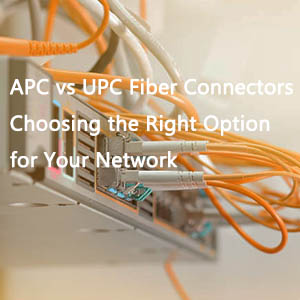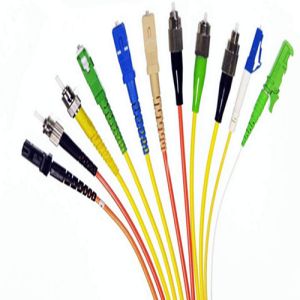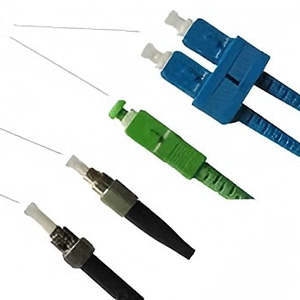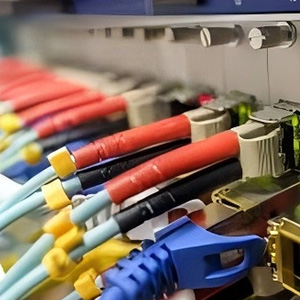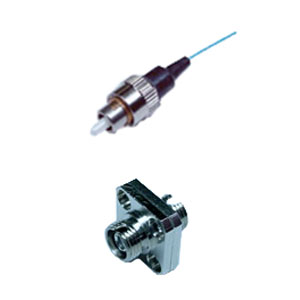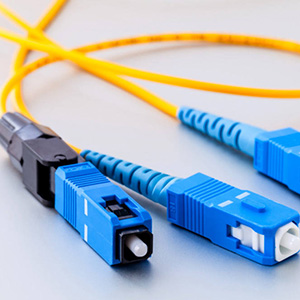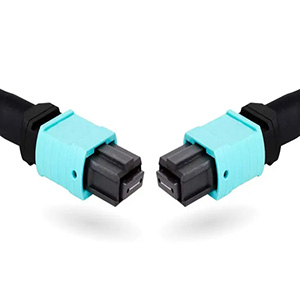Fiber optic adapter (also known as flange), also called fiber optic connector, is a centering connection component of fiber optic active connector. Fiber optic connector is the most widely used optical passive device in fiber optic communication system. Most fiber optic connectors are composed of three parts: two fiber optic connectors and a coupler. The two fiber optic connectors are installed into the tail ends of the two optical fibers; the coupler plays the role of aligning the sleeve. In addition, the coupler is mostly equipped with metal or non-metallic flanges to facilitate the installation and fixation of the connector.
Ⅰ.Fiber Optic Adapter (Also Known As Flange)
also called fiber optic connector, is a centering connection component of fiber optic active connector. Fiber optic connector is the most widely used optical passive device in fiber optic communication system. Most fiber optic connectors are composed of three parts: two fiber optic connectors and a coupler. The two fiber optic connectors are installed into the tail ends of the two optical fibers; the coupler plays the role of aligning the sleeve. In addition, the coupler is mostly equipped with metal or non-metallic flanges to facilitate the installation and fixation of the connector.
Ⅱ.Features Of Fiber Optic Adapter
Passed 100% optical performance testing, ceramic (zirconia) sleeve, processed by imported high-precision machine tools, high product finish, precise axis positioning, ensuring product coaxiality and roundness accuracy coefficient
Unique integrated internal structure design, simpler structure, easier to use, easy to assemble, and improved efficiency
Good stability performance, small insertion loss in continuous plug-in and pull-out tests
Ⅲ.Fiber Optic Adapter Performance Indicators
- Insertion loss: ≤0.2dB
- Return loss:>40dB
- ≤0.2dB interchangeability :
- Operating temperature (‘C): -30-+80
- Storage temperature (°C): -40-+85
- Vibration test: ≤0.1dB (10-60Hz, 1.5mm amplitude)
- Tensile strength test: ≤0.1dB
- Repeatability: >1000 times
IV. Classification Of Fiber Optic Adapters
Fiber optic connectors come in various forms. The connector generally used in EPON networks is an APC connector. The end face of the APC is ground into an 8-degree angle in order to reduce reflection. Its industrial standard return loss is -60dB. The APC connector has precise, predetermined angles, predetermined radii and pre-polished sleeves, which can provide excellent performance and can be used with compact key configurations with or without NTT-FC standards.
Depending on the scope and needs of the fiber optic adapter application, in order to be fixed on various panels, the fiber optic adapter is also designed with a variety of fine fixing flanges. The transfer fiber optic adapter can connect different types of fiber optic jumper interfaces and provide connections between different sections. Double or multiple connections can increase the installation density. According to the different appearance structure and docking cross-section, fiber optic adapters can be roughly divided into the following common models: FC, SC, ST, LC, FC-SC, FC-ST, ST-SC, in addition to some male to female conversion fiber optic adapters.
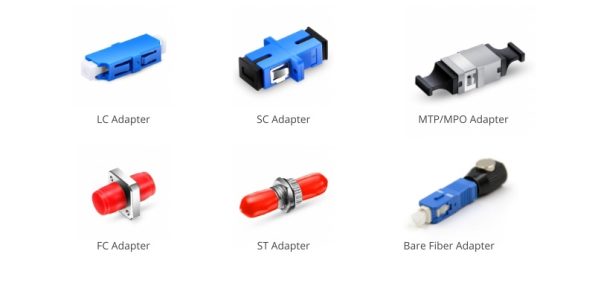
FC fiber optic adapter
Its external reinforcement method is to use a metal sleeve, and the fastening method is a screw buckle. FC type connector, the butt end of the ceramic pin is used. This type of connector has a simple structure, convenient operation, and easy production, but the fiber end face is more sensitive to dust, and it is easy to produce Fresnel reflection, which makes it difficult to improve the return loss performance. Later, this type of connector was improved, using a spherical pin (PC) for the butt end face, while the external structure did not change, which greatly improved the insertion loss and return loss performance.
SC fiber optic adapter
Its shell is rectangular, and the structural dimensions of the pin and coupling sleeve used are exactly the same as those of the FC type. The end face of the pin is mostly ground by PC or APC: the fastening method is a plug-in pin door type, without rotation. Equipped with metal shrapnel, it is easy to use in concealed installation. This type of connector is inexpensive, easy to plug and unplug, has low insertion loss fluctuation, high compressive strength, and high installation density.
ST fiber optic adapter
It is a keyed snap-on locking structure to ensure accurate alignment during connection. It has strong tensile strength and metal key positioning to improve the repeatability and durability of the adapter. It uses precision ceramic or copper sleeves to ensure long-term stable mechanical and optical properties. Rectangular structure, tapping and riveting installation are convenient.
LC fiber optic adapter
It is made of easy-to-operate modular jack (RJ) latch mechanism. The size of the pins and sleeves used is small, which improves the density of fiber optic connectors in the fiber optic distribution frame. Precision ceramic sleeves are used to ensure long-term stable mechanical and optical properties.
V. Common Fiber Optic Connectors
(1) FC type fiber optic connector
This connector was first developed by NTT of Japan. FC is the abbreviation of FERRULECONNECTOR, indicating that its external reinforcement method is a metal sleeve and the fastening method is a screw buckle. At first, the FC type connector used a ceramic pin butt end.
This type of connector has a simple structure, is easy to operate and manufacture, but the fiber end face is more sensitive to dust and is prone to Fresnel reflection, making it difficult to improve the return loss performance. Later, this type of connector was improved by using a spherical pin (PC) with a butt end face, while the external structure remained unchanged, which greatly improved the insertion loss and return loss performance.
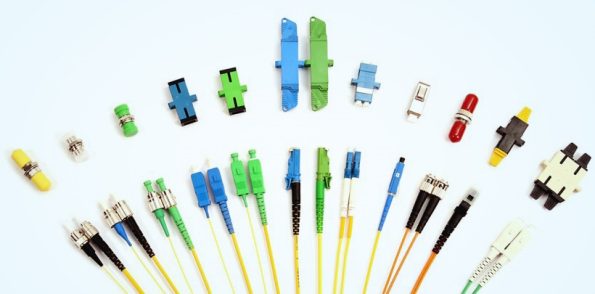
(2) SC type fiber optic connector
This is a fiber optic connector developed by NTT Corporation of Japan. Its shell is rectangular, and the structural dimensions of the pin and coupling sleeve used are exactly the same as those of the FC type. The end face of the pin is mostly ground by PC or APC type; the fastening method is a plug-in pin door type, which does not require rotation.
This type of connector is low-priced, easy to plug and unplug, has small insertion loss fluctuations, high compressive strength, and high installation density. ST and SC interfaces are two types of fiber optic connectors. For 10BASE-F connections, the connector is usually of ST type, and for 100BASE-FX, the connector is mostly of SC type. The core of the ST connector is exposed, while the core of the SC connector is inside the connector.
(3) Biconical connector (BICONIC CONNECTOR)
The most representative product of this type of fiber optic connector was developed by Bell Laboratories in the United States. It consists of two cylindrical plugs with truncated cones formed by precision molding and a coupling component with a biconical plastic sleeve inside.
(4) DIN47256 fiber optic connector
This is a connector developed by Germany. The structural dimensions of the pins and coupling sleeves used in this connector are the same as those of the FC type, and the end face processing adopts PC grinding. Compared with the FC type connector, its structure is more complicated, and there is a spring in the internal metal structure to control the pressure, which can avoid damage to the end face due to excessive plugging pressure. In addition, the mechanical precision of this connector is higher, so the insertion loss value is smaller.
(5) MT-RJ connector
MT-RJ originated from the MT connector developed by NTT. It has the same latching mechanism as the RJ-45 LAN electrical connector. The optical fiber is aligned by the guide pins installed on both sides of the small sleeve. To facilitate connection with the optical transceiver, the optical fiber on the connector end face is designed with a dual-core (0.75MM spacing). It is the next generation of high-density optical fiber connector mainly used for data transmission.
(6) LC connector
The LC connector was developed by the famous BELL Research Institute and is made of an easy-to-operate modular jack (RJ) latching mechanism. The size of the pin and sleeve used is half of the size used by ordinary SC, FC, etc., which is 1.25MM. This can increase the density of optical fiber connectors in the optical fiber distribution frame. At present, in the single-mode SFF field, the LC type connector has actually occupied a dominant position, and its application in multi-mode is also growing rapidly.
(7) MU connector
The MU (MINIATURE UNIT COUPLING) connector is based on the currently most used SC type connector and is developed by NTT to be the world’s smallest single-core optical fiber connector. The connector uses a 1.25MM diameter sleeve and a self-retaining mechanism, and its advantage is that it can achieve high-density installation. Using the MU’s L.25MM diameter sleeve, NTT has developed the MU connector series. They have socket-type connectors for optical cable connections (MU-A series); backplane connectors with self-retaining mechanisms (MU-B series) and simplified sockets for connecting LD/PD modules and plugs (MU-SR series). With the rapid development of optical fiber networks towards larger bandwidth and larger capacity and the widespread application of DWDM technology, the demand for MU-type connectors will also grow rapidly.
Ⅵ.The Role Of Optical Fiber Adapters
Like optical fiber connectors, optical fiber adapters are also components that play a connecting role in optical fiber lines. The difference is that optical fiber connectors can only be used to connect optical cables of the same model or devices of the same model. Once the models of the two connected optical cables and devices do not match, they will be at a loss. The optical fiber adapter is different. There are multiple input and output ports of different models on its box, so that any type of optical fiber line and device can be easily connected. Another function of the fiber optic adapter is to establish a signal branch. As mentioned above, there are several outlets on the box of the fiber optic adapter, and each outlet can establish a branch line.
VII. Application Scope Of Fiber Optic Adapter
- Fiber optic communication system
- Cable TV network
- Local area network, optical area network
- Fiber to the home (FTTP)
- Video transmission
- Test instrument


